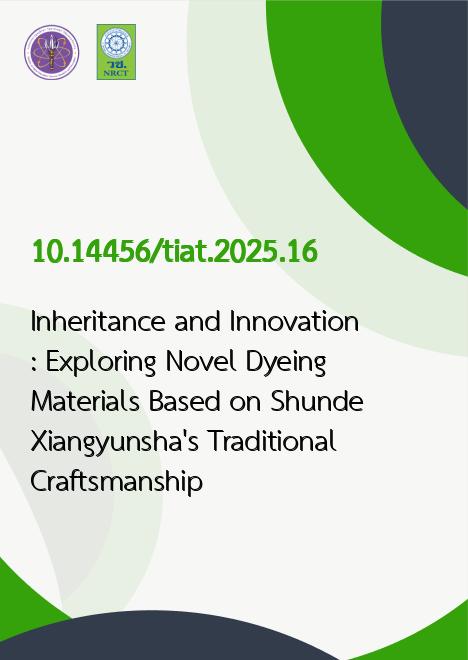
|
Inheritance and Innovation: Exploring Novel Dyeing Materials Based on Shunde Xiangyunsha's Traditional Craftsmanship |
|---|---|
| รหัสดีโอไอ | |
| Creator | Yanping Zeng |
| Title | Inheritance and Innovation: Exploring Novel Dyeing Materials Based on Shunde Xiangyunsha's Traditional Craftsmanship |
| Contributor | Chusak Suvimolstien, Poradee Panthupakorn, Suwichai Kosaiyawat |
| Publisher | Kalasin University |
| Publication Year | 2568 |
| Journal Title | Asian Journal of Traditional and Innovative Arts and Textiles |
| Journal Vol. | 4 |
| Journal No. | 3 |
| Page no. | 225-240 |
| Keyword | Xiangyunsha, Shunde traditional craft, Natural dyeing, Yam, Pomegranate peel dye, Cultural heritage innovation |
| URL Website | https://so06.tci-thaijo.org/index.php/TIAT/article/view/287163 |
| Website title | https://so06.tci-thaijo.org/index.php/TIAT/ |
| ISSN | 2821-921X (Online) |
| Abstract | This study centers on inheritance and innovation Shunde Xiangyunsha's traditional craftsmanship, aiming to explore novel dyeing materials to address the increasing scarcity of its core raw material, Dioscorea cirrhosa (Shǔ Liáng). This qualitative research, conducted from March to June 2025, used a systematic approach to collect and analyze Xiangyunsha’s craftsmanship and its connection to Shunde's geographical and cultural ecology. The primary tools were interviews and field observations at the Fuxing Guoni Field, where empirical data for new material application was gathered. The study's target groups included 2 Xiangyunsha inheritors, 3 practitioners, 3 textile professionals, and 15 Lunjiao community residents, totaling 23 individuals. We first elucidate Xiangyunsha's rich historical legacy as a national intangible cultural heritage and its unique "harmony between nature and humanity" ecological wisdom, detailing its complex manual dyeing principles, combining Shǔ Liáng plant dyeing with the "guo-wu" (blackening) process using iron-rich river mud, specifically highlighting the complexation reaction between tannins and iron ions. To overcome raw material bottlenecks and promote Xiangyunsha's sustainable development, this research deeply analyzed the traditional dyeing mechanisms and conducted innovative experiments at the Fuxing Guoni Field. We selected pomegranate peels, this tannin-rich plant, as an alternative dye; its extraction methods, immersion dyeing procedures, and the critical river mud "guo-wu" process were explored and validated. Results indicate that Xiangyunsha's traditional dyeing heavily relies on environmental factors and the iron ion content in the river mud. Furthermore, after multiple immersions and river mud treatments, pomegranate peels initially demonstrated the potential to complex with river mud iron ions, confirming the feasibility of novel plant dyeing materials in broadening Xiangyunsha's raw material sources. The Conclusion and Discussion section emphasizes that this exploration not only contributes to preserving Xiangyunsha's unique techniques but also achieves innovation by introducing readily available alternative materials, with future research focusing on quantitatively comparing the dyeing effects, colorfastness, and durability of these new materials, along with optimizing process parameters, to promote Xiangyunsha's contemporary innovation and market application while retaining its cultural essence. |